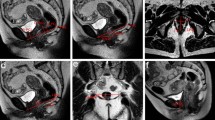Abstract
Pelvic magnetic resonance is a simple and non-invasive imaging technique for dynamic and static assessment of the pelvic floor. The morphology of the support system is assessed by T2-weighted images. Dynamic sequences are used to assess pelvic prolapse. In this study we illustrate the normal and pathologic features of the levator ani muscle which represents the main active support of pelvic organs. Furthermore we describe the different types of prolapses, floor by floor, and the different staging techniques.

















Similar content being viewed by others
References
Hodroff MA, Stolpen AH, Denson MA, et al. (2002) Dynamic magnetic resonance imaging of the female pelvis: the relationship with the Pelvic Organ Prolapse quantification staging system. J Urol 167(3):1353–1355
Etlik O, Arslan H, Odabasi O, et al. (2002) The role of the MR-fluoroscopy in the diagnosis and staging of the pelvic organ prolapse. Eur J Radiol 53:136–141
Cruikshank SH (1987) Preventing posthysterectomy vaginal vault prolapse and enterocele during vaginal hysterectomy. Am J Obstet Gynecol 156:1433–1440
DeLancey JO (2005) The hidden epidemic of pelvic floor dysfunction: achievable goals for improved prevention and treatment. Am J Obstet Gynecol 192:1488–1495
Olsen AL, Smith VJ, Bergstrom JO, et al. (1997) Epidemiology of surgically managed pelvic organ prolapse and urinary incontinence. Obstet Gynecol 89:501–506
Weidner AC, Low VH (1998) Imaging studies of the pelvic floor. Obstet Gynecol Clin North Am 25:825–848
Kester RR, Leboeuf L, Amendola MA, et al. (2003) Value of express T2-weighted pelvic MRI in the preoperative evaluation of severe pelvic floor prolapse: a prospective study. Urology 61:1135–1139
Deval B, Vulierme MP, Poilpot S, et al. (2003) Imaging pelvic floor prolapse. J Gynecol Obstet Biol Reprod 32:22–29
Lienemann A, Fischer T (2003) Functional imaging of the pelvic floor. Eur J Radiol 47:117–122
Pannu HK (2004) MRI of pelvic organ prolapse. Eur Radiol 14:1456–1464
Maubon A, Aubard Y, Berkane V, et al. (2003) Magnetic resonance imaging of the pelvic floor. Abdom Imaging 28:217–225
DeLancey JO (1994) The anatomy of the pelvic floor. Curr Opin Obstet Gynecol 6:313–316
Klutke CG, Siegel CL (1995) Functional female pelvic anatomy. Urol Clin North Am 22:487–498
Healy JC, Halligan S, Reznek RH, et al. (1997) Patterns of prolapse in women with symptoms of pelvic floor weakness: assessment with MR imaging. Radiology 203:77–81
Gufler H, Laubenberger J, DeGregorio G, et al. (1999) Pelvic floor descent: dynamic MR imaging using a half-Fourier RARE sequence. J Magn Reson Imaging 9:378–383
Kelvin FM, Hale DS, Maglinte DD, et al. (1999) Female pelvic organ prolapse: diagnostic contribution of dynamic cystoproctography and comparison with physical examination. AJR Am J Roentgenol 173:31–37
Yang A, Mostwin JL, Zerhouni EA (1991) Pelvic floor descent in women: dynamic evaluation with fast MR imaging and cinematic display. Radiology 179:25–33
Fielding JR, Griffiths DJ, Versi E, et al. (1998) MR imaging of pelvic floor continence mechanisms in the supine and sitting positions. AJR Am J Roentgenol 171:1607–1610
Kelvin FM, Maglinte DD, Hale DS, et al. (2000) Female pelvic organ prolapse: a comparison of triphasic dynamic MR imaging and triphasic fluoroscopic cystocolpoproctography. AJR Am J Roentgenol 174:81–88
Healy JC, Halligan S, Reznek RH, et al. (1997) Dynamic MR imaging compared with evacuation proctography when evaluating anorectal configuration and pelvic floor movement. AJR Am J Roentgenol 169:775–779
Singh K, Reid WM, Berger LA (2001) Assessment and grading of pelvic organ prolapse by use of dynamic magnetic resonance imaging. Am J Obstet Gynecol 185:71–77
Lienemann A, Anthuber C, Baron A, et al. (1997) Dynamic MR colpocystorectography assessing pelvic-floor descent. Eur Radiol 7:1309–1317
Siproudhis L (1998) Therapeutic approaches to rectal prolapse. Gastroenterol Clin Biol 22:134–141
Author information
Authors and Affiliations
Corresponding author
Rights and permissions
About this article
Cite this article
Mondot, L., Novellas, S., Senni, M. et al. Pelvic prolapse: static and dynamic MRI. Abdom Imaging 32, 775–783 (2007). https://doi.org/10.1007/s00261-006-9168-y
Published:
Issue Date:
DOI: https://doi.org/10.1007/s00261-006-9168-y




